Day 2 of two days of Private Tours today, and it was down to the Brecks for the day. We were originally forecast showers and brighter intervals, but this morning they changed their minds – a more organised band of rain was now expected. So it turned out, but at least it cleared through quickly and we even had a bit of brighter weather in the afternoon. As ever, it didn’t stop us getting out and seeing some really good birds!
One of the targets for the day was to be Goshawk, but the weather forecast was far from ideal now. We swung round first thing via one of the sites where we might hope to see them, but it was very damp, grey and misty. We decided to try for some of our other targets in the general area, so we could come back if the weather improved.
As we drove away, we noticed lots of thrushes, Fieldfares and Redwings in some low winter wheat. On the other side of the road, several Chaffinches were dropping down to feed in a weedy field. When we stopped to look through them, we noticed there were thrushes out here too. A single Mistle Thrush flew out to join them.
At least it wasn’t raining when we pulled up at the head of one of the rides leading into the Forest. Three Yellowhammers were sitting in the top of a small oak tree as we walked along the track. They flew off as we approached and landed in the top of another very tall tree out in the middle of a clearing.
We walked along the path around the edge of the clearing and, as we did so, we noticed a Woodlark flutter up from out in the middle and land in the top of the same tall tree. It wasn’t singing – perhaps not a surprise given the weather – but we had a nice view through the scope. This was the species we had come here to see, so it was good to get one under our belt.
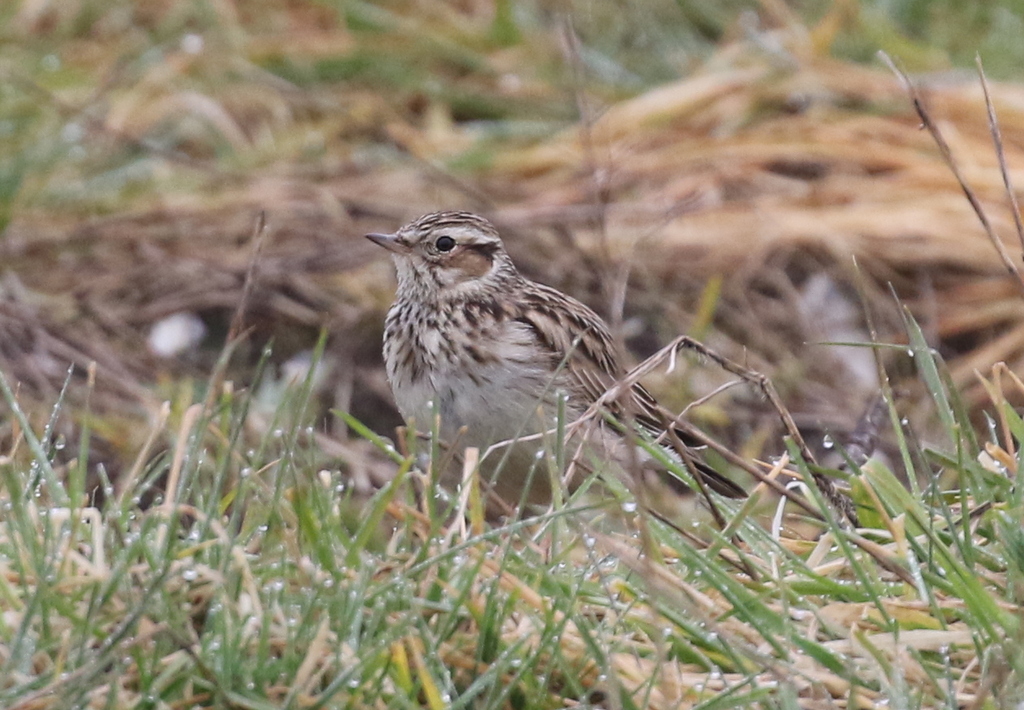
A little further along the path and we heard another Woodlark calling, in the edge of the clearing much closer to us. We stopped and scanned the ground and it flew up and landed a short distance back along the path. When we looked across where it had landed, there were now three Woodlarks together here. We walked back slowly and had a great view of them as they walked around in the low grass.
Two of the Woodlarks seemed to be following each other closely, while the third fed quietly nearby. The two were bobbing up and down nervously, calling. It looked like they might be two males, having a bit of a territorial dispute, while the female was busy feeding – the third bird looked a little duller coloured. Eventually, one of the two Woodlarks flew up in one direction, where a fourth bird called in response, and the pair flew off the other way.
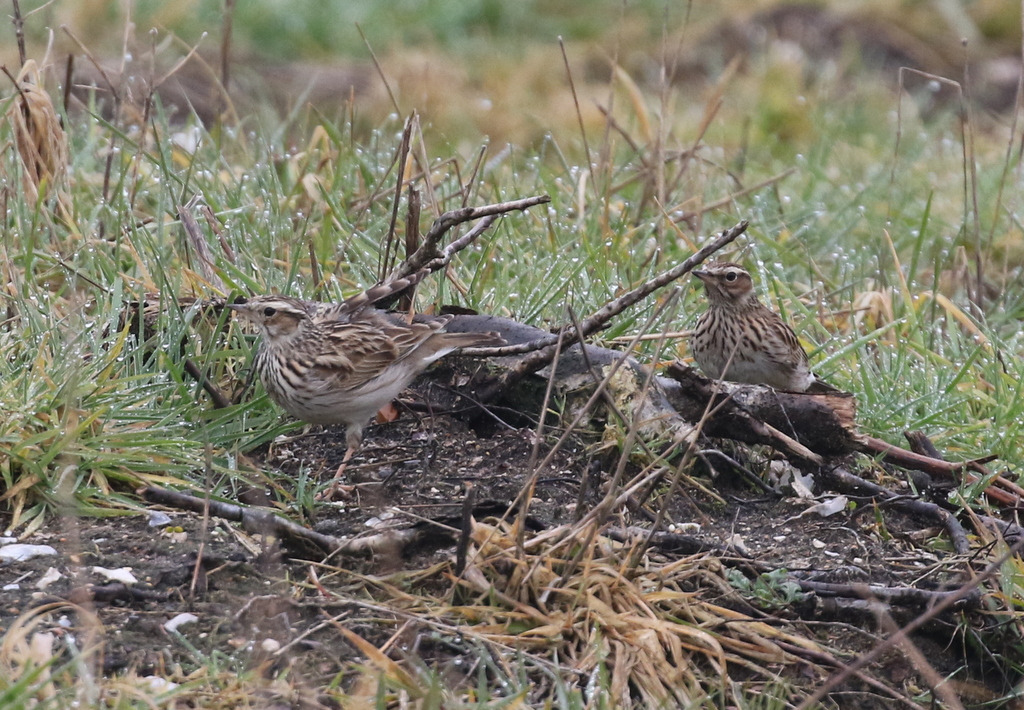
Having had great views of the Woodlarks, we headed off to another ride through the Forest to look for Willow Tits, while we waited for the weather to brighten up. As we walked in through the trees, it was rather quiet initially but when we got to one of the feeding stations put out for them on the edge of the pines, there was a lot more activity. A steady stream of birds were coming and going.
As we stood and watched for a while, we saw a very good selection of tits – lots of Coal Tits, Blue Tits and Great Tits, and several Marsh Tits. A family of Long-tailed Tits passed through the trees overhead. A Nuthatch came in to grab some sunflower seeds too. The Willow Tits here don’t seem to visit the feeding tables very often, but they can often be heard calling and singing in the vicinity. Unfortunately, in the cold grey weather there was very little vocal activity from any of the birds today.
Then it started to rain. We decided to head back to the car and go off to try something else instead. With no sign of the weather improving, we headed over to look for one of our other targets for the day, Common Crane. As we drove west towards Lakenheath, the sky seemed to brighten and the rain started to ease again.
Given the weather, we decided to drive round the area and try to find the Cranes feeding in the fields first, rather than walk out across the road. As we checked out some of the favoured spots, a Kingfisher perched on the edge of a drainage ditch by the road was a welcome sight. A Great White Egret out in the middle of a field took off as we pulled up and flapped away lazily, dropping down out of view.
Scanning the rushy meadows carefully, we found a pair of Cranes out in one of the fields. The rain had stopped now and they were busy preening, presumably drying themselves out. For such tall birds, they are remarkably inconspicuous on the ground, but when they stretched up we could see their black and white heads and long necks.

With the weather improving and our main target here achieved, we headed round to the RSPB reserve at Lakenheath Fen for a quick look out at the Washland. There were lots of Reed Buntings on the feeders, but they flew off into the bushes as soon as we came outside. As we walked down the path towards the river, the sun came out and it was lovely and warm as we climbed up onto the bank.
The water levels here are not surprisingly high at the moment – lots of water for wildfowl. A quick look at a party of five swans over the back of the pool confirmed they were Whooper Swans – we could see their wedge-shaped bills with a long tongue of yellow stretching down to a point.
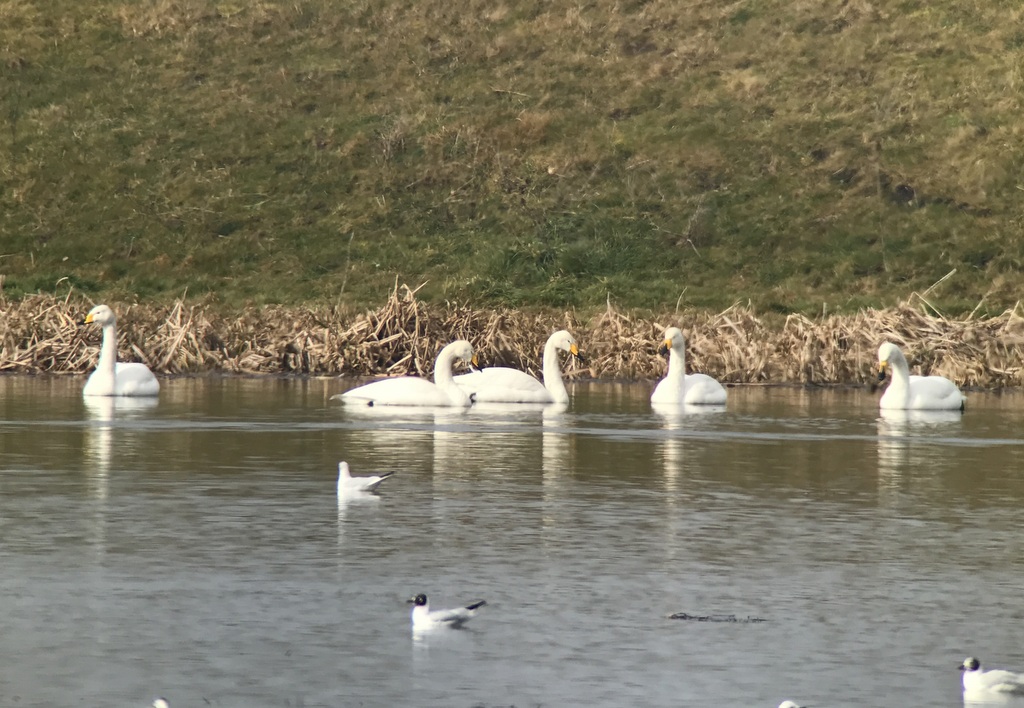
There were plenty of ducks on here too – Wigeon, Shoveler, Gadwall, Teal and Shelduck. This is always a good spot for Garganey in spring and with the very first birds already arriving in the country in recent days we had a careful scan just in case. There was no sign of one today, but surely it is just a matter of a week or so, if the weather continues to warm up. Lots of Tufted Ducks were diving on the river.
The only egret we could see at first was a Little Egret tucked down in the reeds on the far side of the river. There are normally Great White Egrets here too, and we eventually managed to find one in the distance away downstream.
A Water Pipit had flown off calling as we walked up onto the bank and after a while what was presumably the same bird flew back past us. Another one flew up from the thick vegetation below the bank as it called and landed a little further along. We had a quick look for it, but with the water levels high they were feeding in the thicker rushes today.
With the weather now warming up nicely, we decided to have another go for Goshawks while we had our lunch. Unfortunately, it proved to be just a transitory window of brightness and it clouded over again as we drove back into the Forest. At least it was dry now though.
As we ate our sandwiches, we scanned the trees. There were a few raptors up from time to time. The Common Buzzards were spiraling up in little groups, looking for thermals to gain height, although they never seemed to gain any great elevation. At one point, we had eight in the air circling together. A Red Kite appeared behind us in the distance, and a Sparrowhawk was displaying a long way off too. A Kestrel perched in the top of a fir tree.
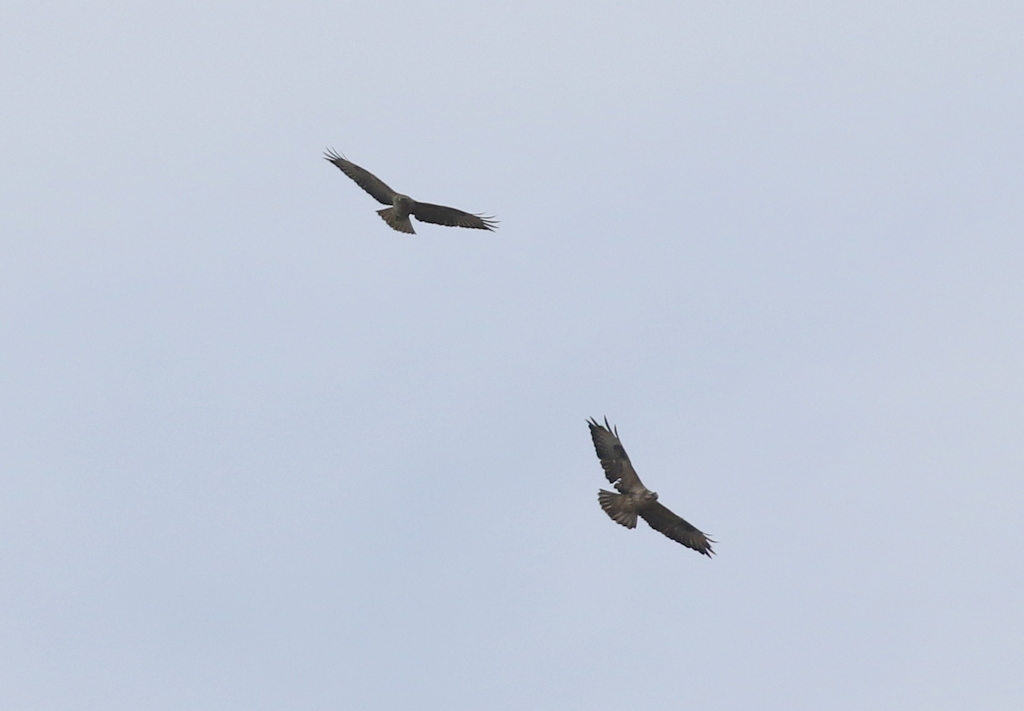
After a while, we did manage to spot a Goshawk. It too was some way off, but it circled up and started displaying, flying across with deep, exaggerated wingbeats. It dropped down behind the trees, but we guessed it was still in the area as the Woodpigeons over that way scattered in alarm. A short while later, what was presumably the same Goshawk circled up and displayed for a couple of minutes more.
The forecast had indicated it might brighten up early in the afternoon, but there was no sign of that happening yet. There were a few other birds here to distract us. Lots of Chaffinches were feeding under the trees and when they flew out a Brambling appeared with them and landed in a small oak in front of us. A Treecreeper appeared too, working its way up and down the trunks, and a flock of Fieldfares flew over, ‘tchack, tchacking’ loudly.
At least we had managed to see a Goshawk, despite the weather. We decided to head down to Lynford Arboretum for the rest of the afternoon. As we walked in along the path, we could hear a Siskin singing high in the larches. There were lots of tits covering the cage of fatballs looking in from the gate, and plenty of Chaffinches down in the leaf litter below.
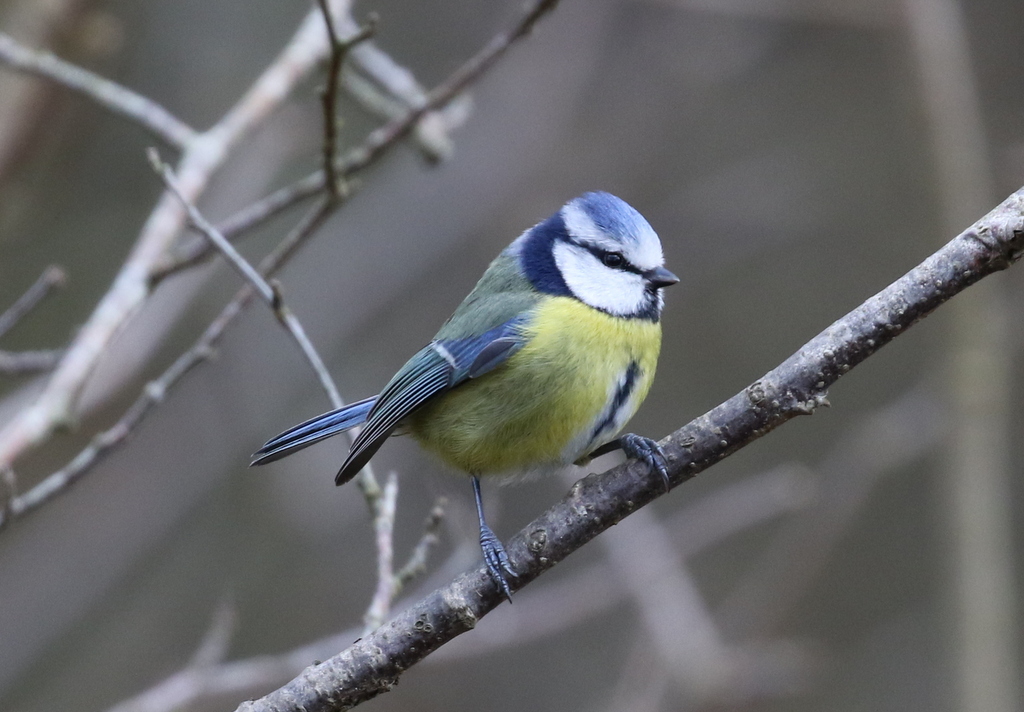
There was no food out down at the bridge when we arrived, but fortunately we had brought supplies with us today. Only a few seconds after putting out some sunflower seeds, the hordes began to descend. At first, the Blue Tits, Great Tits and Coal Tits appeared, quickly joined by a couple of Marsh Tits.
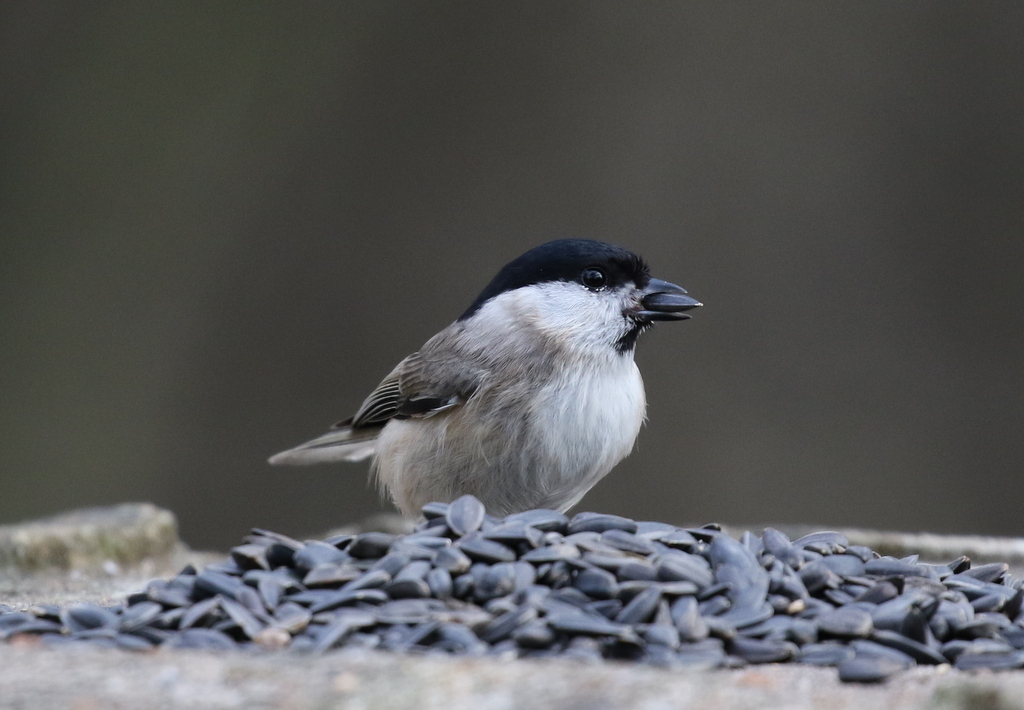
They were then joined by a couple of Nuthatches, which made repeated forays in from the trees, grabbing a beakful of seeds each time, presumably stashing them somewhere away in the wood. We stopped and spent a while photographing all the birds coming in to feed.
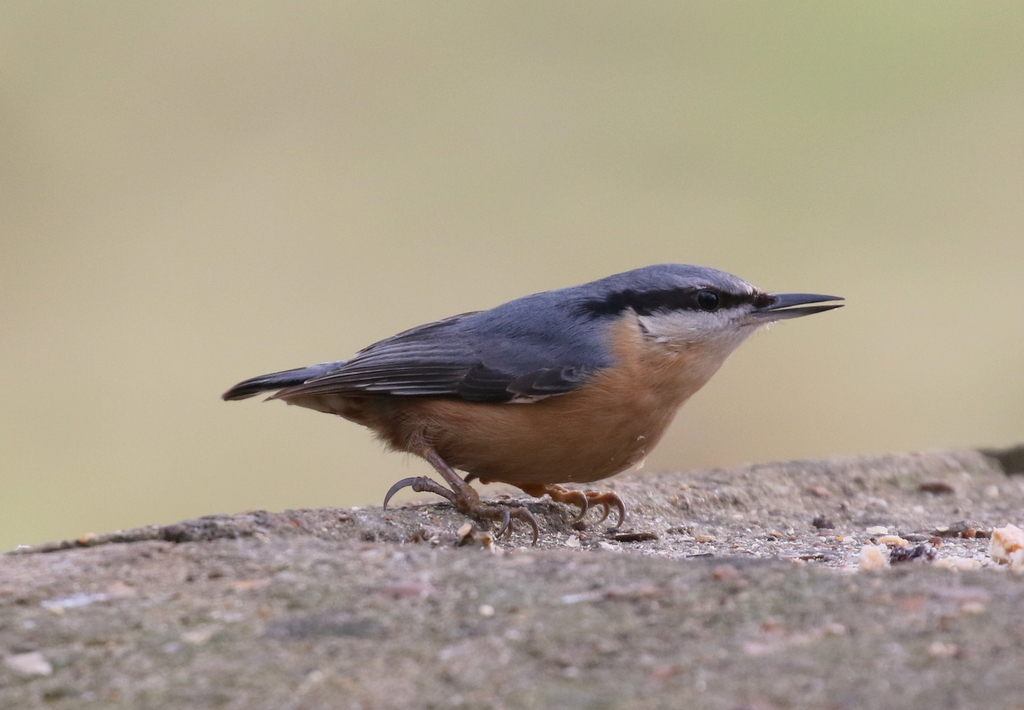
There had been a lot of disturbance out over the paddocks when we arrived, with military helicopters repeatedly circling out very low from the battle area. We had a walk down to see if we could find any Hawfinches feeding there, but there was no sign of them this afternoon. There were fewer other finches feeding under the trees than normal too, with just one Brambling today and a 2-3 each of Greenfinch and Chaffinch.
The flock of Redwings had been in the trees just beyond the bridge when we arrived, but had now flown back out into the paddocks, along with a couple of Mistle Thrushes. A Great Spotted Woodpecker was chipping away at a branch low down in the hornbeams.
While we were standing and looking at the trees in the paddocks, we heard some distant yelping, honking noises. It was hard to work out where they were coming from at first, but then we realised they were swans calling and a large flock of 58 came over the trees at the back. They flew straight towards us over the paddocks and over our heads, Bewick’s Swans heading off east.
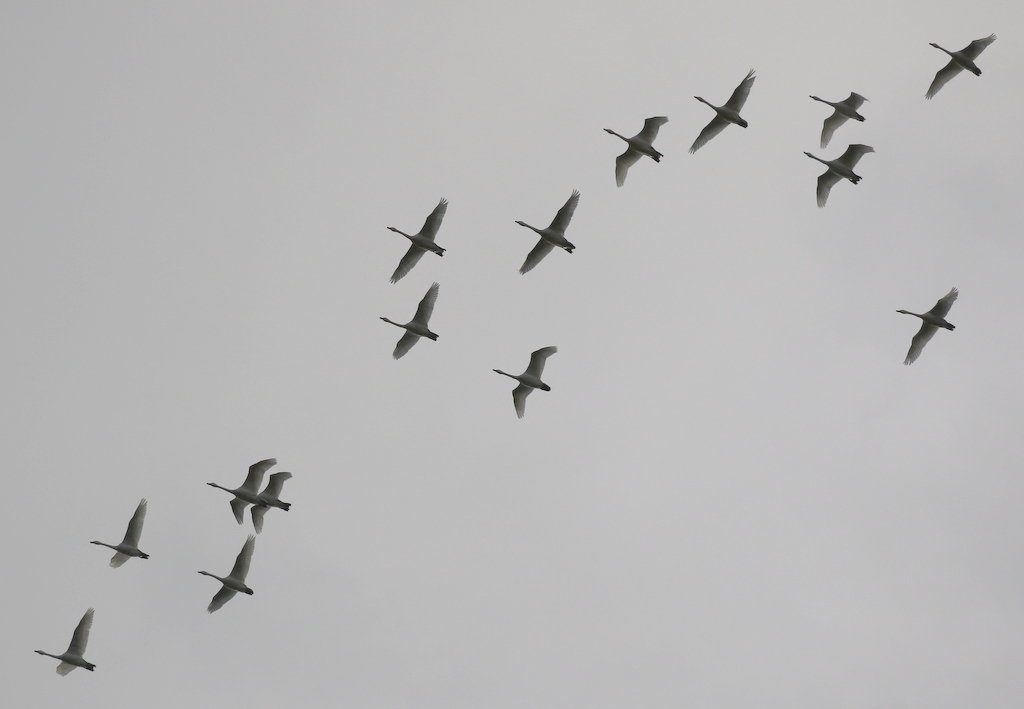
Bewick’s Swans are on the move at the moment, leaving their wintering grounds at Welney and Slimbridge and heading back to the continent on their way back towards their breeding grounds in Russia. It was great to see and hear them as they passed over us. It was quite late in the day and they were flying rather low, so perhaps they were planning to stop off somewhere in east Norfolk for the night.
We still hadn’t seen any Hawfinches though, so we walked further up along the edge of the paddocks, scanning the trees. The sky had cleared and the sun was out now. Suddenly we noticed two birds fly in and land in the top of a fir tree at the back – two Hawfinches. They were silhouetted against the light, but we assumed they would sit in the tops for a while in the late afternoon sunshine. We walked round to where we might get a better view of them, but by the time we got there they had dropped down out of sight.
We waited a while, scanning the trees, and it wasn’t long before another Hawfinch appeared in the tops. From where we were standing, we had a much better look at this one, catching the sun. We could see its enormous bill, bright chestnut plumage, and white tip to the tail. We had a good look at it through the scope, a cracking male, but when we tried to reposition ourselves for a closer look it too had dropped down into the trees.

We still wanted to have a quick look at the gravel pits, so we decided to make our way back. At the bridge, the sunflower seeds we had put out had already all gone! As we walked up towards the pits, a Green Woodpecker laughed and flew across behind us. We had received a message to say that there was a pair of Goosander on the pits this afternoon and when we arrived we immediately spotted one, a redhead, resting on one of the platforms.
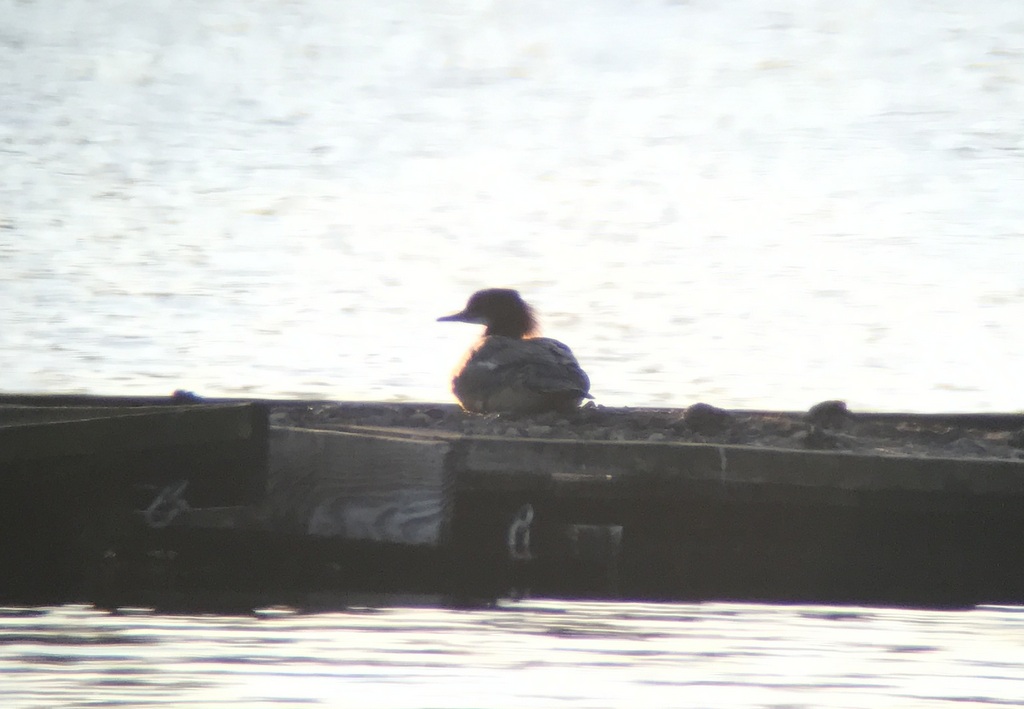
There was no sign of the male Goosander though at first, but after scanning from the hide for a few seconds, he appeared from behind the trees at the back, accompanied by another female. There was a single male Goldeneye on here too, and three further drakes on the other pit.
It was getting late now and we had to be back, so we made our way back to the car. As we got to the car park, a Firecrest was calling from somewhere high in the fir trees, although it proved difficult to see before it went quiet. That would have been a nice way to end, but it was starting to get dark as we drove back and the return journey added no less than 4 Barn Owls and a couple of Woodcock zipping past in the dusk. Then it was back home for tea (and medals?!).
















